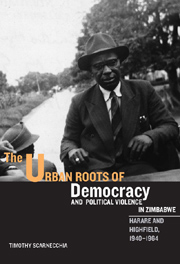Book contents
- Frontmatter
- Contents
- List of Illustrations
- Acknowledgments
- List of Abbreviations
- Notes to the Reader
- Introduction
- 1 Charles Mzingeli's Leadership and Imperial Working-Class Citizenship
- 2 Township Protest Politics
- 3 Resistance to the Urban Areas Act and Women's Political Influence
- 4 Changing Tactics: Youth League Politics and the End of Accommodation
- 5 The Early Sixties: Violent Protests and “Sellout” Politics
- 6 The “Imperialist Stooge” and New Levels of “Sellout” Political Violence
- 7 The ZAPU-ZANU Split and the Battlegrounds of Harare and Highfield
- Conclusion
- Notes
- Selected Bibliography
- Index
- Title in the series
4 - Changing Tactics: Youth League Politics and the End of Accommodation
Published online by Cambridge University Press: 12 September 2012
- Frontmatter
- Contents
- List of Illustrations
- Acknowledgments
- List of Abbreviations
- Notes to the Reader
- Introduction
- 1 Charles Mzingeli's Leadership and Imperial Working-Class Citizenship
- 2 Township Protest Politics
- 3 Resistance to the Urban Areas Act and Women's Political Influence
- 4 Changing Tactics: Youth League Politics and the End of Accommodation
- 5 The Early Sixties: Violent Protests and “Sellout” Politics
- 6 The “Imperialist Stooge” and New Levels of “Sellout” Political Violence
- 7 The ZAPU-ZANU Split and the Battlegrounds of Harare and Highfield
- Conclusion
- Notes
- Selected Bibliography
- Index
- Title in the series
Summary
In the early 1950s, at a time when the British were beginning to develop ways to accommodate nationalist leaders' demands to decolonize the Empire's African possessions, white politicians in Southern Rhodesia developed and advocated to Britain a plan to unite Southern Rhodesia with the two British colonies of Nyasaland and Northern Rhodesia. This Central African Federation would last for about ten years (1953–63) and proved to be very profitable for white interests, particular for those in Salisbury who made their city the capital of the Federation. Increased demands for copper from Northern Rhodesia benefited businesses in Southern Rhodesia as well. African politicians in all three territories, after many initially worked within the framework of the proposed “partnership” between the races, began by the late 1950s to organize a common strategy to end the Federation in order to move toward greater African political and economic advancement—and majority rule. During and after the battle over federation in the early 1950s, at the local level in Harare township, only the RICU had any sizable active mass support, and here Mzingeli's leadership had proven itself to be non-confrontational. The RICU continued to control the township's advisory board and membership of the Salisbury and District African Welfare Society, the two government sponsored bodies in which Africans had some representation. From the vantage point of European authorities at the beginning of the Federation, the potential for organized opposition in Southern Rhodesia on the same scale and intensity that was developing in Northern Rhodesia, Nyasaland, and South Africa was viewed as slim.
- Type
- Chapter
- Information
- The Urban Roots of Democracy and Political Violence in ZimbabweHarare and Highfield, 1940–1964, pp. 69 - 93Publisher: Boydell & BrewerPrint publication year: 2008



